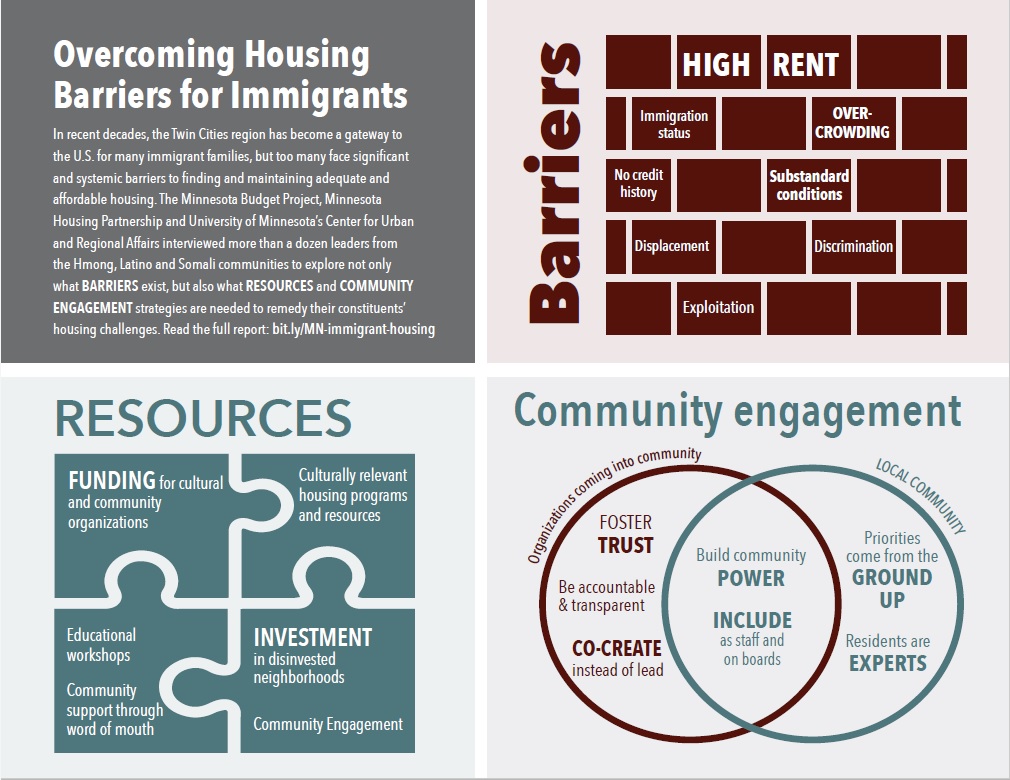A collaborative project among the Minnesota Budget Project, the Minnesota Housing Partnership and the University of Minnesota’s Center for Urban and Regional Affairs.
Executive Summary
In many ways, housing is integral to the American Dream. Since the inception of the United States, finding safe haven has been a driving force for millions of American immigrants. They come seeking the opportunity to build a better life for themselves and their children — and fulfilling those dreams are inextricably tied to finding a stable, affordable place to call home.
Despite the resilience of immigrants, many systemic barriers have been created to determine what populations have the most access to housing and where. So, for many immigrants even today, the dream of a securing a safe, healthy, affordable home is out of reach.
In recent decades, the Twin Cities region has become a gateway to the U.S. for many immigrant families. Between 2000 and 2015, the number of foreign-born residents contributing to the region rose by 74 percent, rising from 206,500 to 359,500. Today, 12 percent of all Twin Cities metropolitan area residents are foreign-born and 23 percent of children under the age of 18 are either foreign-born or have at least one foreign-born parent.
Immigrants are integral to the communities they settle in. However, even years after they arrive, many immigrants face significant and urgent challenges finding and maintaining adequate and affordable housing. A growing number of the region’s residents pay more than they can afford for housing, forcing them to live in substandard conditions or forgo other necessities like food, medicine or transportation — and these challenges disproportionately impact communities of color, including immigrants. In fact, almost 40 percent of immigrant households in the Twin Cities metropolitan area are “cost burdened,” meaning they pay more than 30 percent of their income on housing. While the number of foreign-born residents in the Twin Cities is on the rise, the vacancy rate for apartments in the Twin Cities remains low, creating a difficult, crowded market for affordable housing options. These challenges persist in home ownership, as well, with immigrant and people of color-led households far less likely to own their homes than white households.
But the challenges faced by the region’s immigrant populations go beyond financial constraints. Previous research and local narrative data reveal a wealth of distinct barriers faced by newly arrived and settled immigrants. Given the urgent need to identify lasting solutions for the growing immigrant community so that all of our region’s residents can thrive, the Minnesota Housing Partnership, Minnesota Budget Project and the University of Minnesota’s Center for Urban and Regional Affairs partnered to better understand the challenges faced by the largest immigrant populations in the Twin Cities: the Hmong, Latino and Somali communities.
Through interviews with a dozen organizations that work with and within these key immigrant communities, we sought to explore not only what barriers exist, but also what recommendations leaders have to remedy their constituents’ housing challenges. Given the predominantly white leadership in the government and advocacy spaces that advance the agenda around affordable housing, we also sought to explore how non-immigrant-led organizations can work more effectively with these communities, through policy priorities and more meaningful community engagement.
This project is not an exhaustive or comprehensive survey of the many organizations doing work in this area. Nor is it an exhaustive or comprehensive survey of the diversity of immigrants and the challenges they face. Our hope is that this snapshot can serve to advance conversations that are already happening, in ways that center the insight and leadership of organizations that work closely with communities that are disproportionately burdened with housing challenges.
